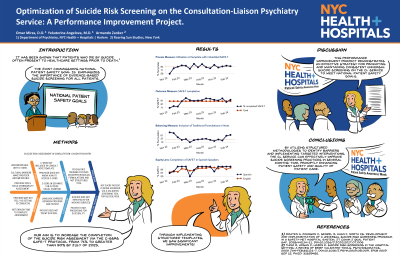Quality and Safety
(163) Optimization of Suicide Risk Screening on the Consultation-Liaison Psychiatry Service: A Performance Improvement Project.

- YA
Yekaterina Angelova, MD (she/her/hers)
Director of Consultation-Liaison Psychiatry
NYC Health + Hospitals | Harlem
New York, New York 
Omar Mirza, DO
Medical Director of Inpatient Psychiatry
NYC Health + Hospitals | Harlem
New York, New York
Presenting Author(s)
Co-Author(s)
Title: Optimization of Suicide Risk Screening on the Consultation-Liaison Psychiatry Service: A Performance Improvement Project. Authors: Omar Mirza, D.O., Yekaterina Angelova, M.D. Background: Suicide prevention has been the focus of clinical providers, administrators and researchers given the global impact of suicide. It has been shown that patients who die by suicide often present to healthcare settings prior to death, and that universal suicide screening can help identify these individuals without placing a significant burden on the healthcare system1,2. As such, the Joint Commission’s National Patient Safety Goal 15 (NPSG 15.01.01) emphasizes the importance of evidence-based suicide screening for all patients and identifies the Columbia Suicide Severity Rating Scale (C-SSRS) as one potential tool. Aim: The aim of this performance improvement study was to examine the barriers to consistent universal suicide screening by the Consultation-Liaison Psychiatry (CL) service and enhance suicide screening for all patients seen by CL in alignment with NPSG 15.01.01. Methods: We conducted a comprehensive analysis of our current suicide screening practices via fishbone and driver diagram methodologies (Fig 1). Key intervention points were identified and we implemented a multifaceted approach to address potential barriers to consistent universal suicide screening. This included provider education initiatives, development of consult note templates to include embedded C-SSRS screen, and integration of redundancy in clinical documentation to reinforce screen completion. Results: Over the course of 1 year (November 2022 – November 2023) following the identification of key intervention points and implementation of above interventions, there was significant improvement in the suicide screening rates on the CL service. Screening rates prior to intervention were consistently below 90%, however, following the implementation of this performance improvement project, screening rates were maintained over 90% for 9 consecutive months. Discussion / Conclusion: This performance improvement project demonstrates an effective strategy for promoting and maintaining consistent universal suicide screening on the CL service to meet national patient safety goals. By utilizing structured methodologies to identify barriers and implementing targeted interventions, the CL service can effectively improve suicide screening practices in several months’ time, promptly enhancing patient safety and quality of patient care. Sources: < !1. Roaten K, Johnson C, Genzel R, Khan F, North CS. Development and Implementation of a Universal Suicide Risk Screening Program in a Safety-Net Hospital System. Jt Comm J Qual Patient Saf. 2018;44(1):4-11. doi:10.1016/j.jcjq.2017.07.006 < !2. Thom R, Hogan C, Hazen E. Suicide Risk Screening in the Hospital Setting: A Review of Brief Validated Tools. Psychosomatics. 2020 Jan-Feb;61(1):1-7. doi: 10.1016/j.psym.2019.08.009. Epub 2019 Sep 12. PMID: 31629482.
Presentation Eligibility: Not previously published or presented
Diversity, Equity, and Inclusion: This project takes into account the rate of suicide screening in English speakers vs. non-English speakers and examines any differences. In fact, results thus far show that Spanish speakers had the highest rate of completed suicide screens, reflecting consideration for equity and inclusion in performance improvement on the CL service.

